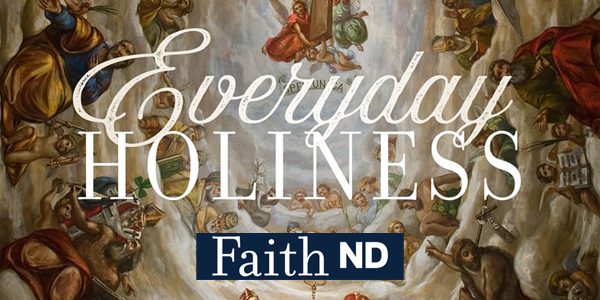The first virtual event in the Medieval Institute’s Pilgrimage for Healing and Liberation series explored pilgrimage as a global, cross-cultural phenomenon in the Middle Ages. This event was moderated by Sr. Annie Killian, OP, Public Humanities Fellow at the Medieval Institute of the University of Notre Dame. Killian spoke with three experts on medieval pilgrimage and members of the Notre Dame faculty: Alexander Hsu, Assistant Teaching Professor of Global Affairs at the Keough School; Robin Jensen, Patrick O’Brien Professor of Theology; and Mun’im Sirry, Associate Professor of Theology. This discussion began with panelists presenting on pilgrimage in the medieval Christian, Buddhist, and Islamic traditions, followed by an opportunity for questions and answers from viewers.
Jensen spoke first about the where, when, and why of Christian pilgrimage. Beginning in the fourth century, pilgrims traveled to Jerusalem to visit the shrine at the tomb of Jesus, known as the Holy Sepulchre, and the site of the Crucifixion. They also sought out saints’ tombs, relics, and other holy objects. Christian pilgrims sought to encounter the divine, and they also went for healing, penance, and adventure. Economically, pilgrimage routes needed to provide lodging, food, care for pilgrims’ animals, guides, and souvenirs. When travel to the Holy Land became difficult, replicas of holy sites were built closer to home, and the devotional form of the Stations of the Cross developed.
Hsu discussed Chinese pilgrimage beginning with the Monk Xuangzang in the seventh century who traveled to India to retrieve Buddhist scriptures and translate them. The word for pilgrim is related to pedestrian and practitioner, signaling that pilgrimage is both a physical and spiritual journey. The monk and his companion the Monkey King embarked on an ascetic journey through inhospitable desert terrain to seek the dharma, that is, teaching or enlightenment. “Seeking the dharma” is one ideal type of Chinese pilgrimage; the other is “visiting the sacred.” From ancient times in the Chinese cultural sphere, people have journeyed to holy mountains to present oneself before the sacred and offer incense. The five sacred mountains in China are holy sites in the Daoist, Confucian, and Buddhist traditions.
Sirry explained that pilgrimage to Mecca, hajj in Arabic, is one of the five pillars of Islam. However, only Muslims who have the financial and physical ability to make the journey are required to do so once in their lifetime. 3 million Muslims travel to Mecca each year, 20% of whom are Indonesian. They save for decades to afford it. For many, the experience is transformative, like starting a new life. When they return home, they receive an honorific title; some change their name. Sirry also talked about Islamic pilgrimage practices at places other than Mecca. In Morocco, pilgrims circle shrines at the tombs of Sufi saints. In Java, Indonesia, Muslims visit sacred mountains and sites like the tomb of Abdurrahman Wahid (Gus Dur), former president of Indonesia. These inter-religious holy places reflect the syncretic religious culture of Java.
During the Q&A, Jensen explained that labyrinths are a pre-Christian symbol for the journey of life. They appear in medieval churches, but we don’t know whether they were used in connection with pilgrimage. Sirry elaborated on the pre-Islamic history of the Kaba. According to tradition, the prophet Muhammad ordered the cleansing of the shrine of all idols except the statues of Jesus and Mary.
Visit the event page for more.



